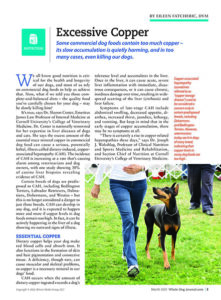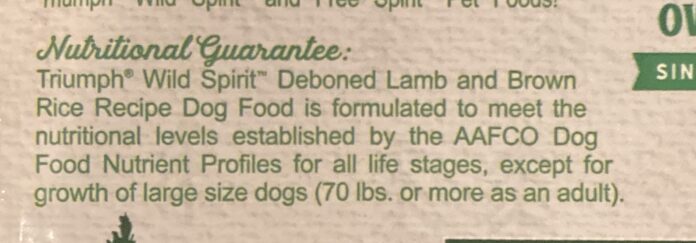Last month, in “Excessive Copper in Dog Food,” we told you how high copper levels in dog food can cause a serious, potentially lethal, illness called dietary-induced, copper-associated hepatopathy (CAH, also known as copper storage disease). The incidence of CAH is increasing at a rate that’s causing alarm among veterinarians and dog owners, with one study showing 30% of canine liver biopsies revealing evidence of CAH.
In that article, we stated that currently, the “recommendation” for the amount of copper in dog food is 7.3 mg/kg (milligrams of copper per kilogram of food).

That’s not quite right – but only because the American organization that sets the standards for what constitutes a complete and balanced diet doesn’t publish recommended levels of any nutrient, just minimums and a few maximums. We should have said that the current legal minimum for copper in non-prescription dog food is 7.3 mg/kg – and owners of dogs who are at risk of developing CAH would be wise to feed only foods with copper levels as close to the minimum as possible.
The European Pet Food Industry Federation (FEDIAF) uses a similar number (a small range, actually) for a minimum copper value in dog diets (7.2 to 8.3 mg/kg) – but it also imposes a maximum value for copper: 28.0 mg/kg. In contrast, the U.S. does not currently impose a maximum allowed value for copper, and it’s easy to find dry dog foods in the U.S. that contain copper levels that far exceed that amount.
Labrador Retrievers are considered at high risk of CAH, as are Bedlington Terriers, Dalmatians, Doberman Pinschers, and West Highland White Terriers. But CAH has been diagnosed with increasing frequency during the past decade in various pure and mixed-breed dogs that are not typically considered predisposed to pathologic copper accumulation. So this issue should be of concern to everyone who feeds their dog a commercial diet.
WHAT CAN YOU DO ABOUT COPPER IN DOG FOOD?
To protect your dog, the first step is to learn how much copper is in your dog’s food; the second is to make sure you feed products with lower copper levels. Taking that first step, unfortunately, often means contacting the maker of your dog’s food and asking about its copper content. And to appreciate the answers to these questions, you first need to understand the terms that may be used in those answers.
Nutritional values may be reported in one of three ways. To compare products, you may have to convert the values reported to you into a different form (or ask the pet food company if they can give you the values in the specific form you need). The three ways that nutrient values may be expressed are:
- As fed. The nutrient levels that are printed on dog food labels are expressed “as fed” – the values given are for the food in its packaged form. For example, Royal Canin’s dry prescription “Hepatic” diet lists its copper content as 7 mg/kg (max) as fed. This means there are a maximum of 7 milligrams of copper per kilogram of the food.
Note: Some food companies may use “parts per million (PPM)” instead of mg/kg. Mathematically, parts per million is equivalent to milligrams per kilogram; 4 ppm is the same thing as 4 mg/kg.
- Dry matter (DM). These values represent the amount of a nutrient present in the food after all the moisture (water) has been removed. Dry dog foods typically contain about 10% moisture; if the moisture was dehydrated away, the weight of the food would be different enough to increase the milligrams per kilogram numbers by about 10%. To use the Royal Canin Hepatic dry food example again, the dry matter value would be reported as 7.8 mg/kg DM (max).
- Caloric basis (kcals). Some companies report their nutrient values on a caloric basis. Copper would be reported as the number of milligrams of copper per 1,000 calories. Reported this way, the Royal Canin Hepatic dry food contains 1.9 mg/1,000 kcal (max).
To review: These are three ways of expressing the same amount of copper in a given food. If you ask a pet food maker for a product’s copper content, you need to be able to recognize their answer as an as-fed, DM, or kcal value so you can make apples-to-apples comparisons to other foods.
CANINE NUTRIENT REQUIREMENTS
The Association of American Feed Control Officials (AAFCO) is the organization responsible for establishing the nutritional standards that legally define “complete and balanced diets” for dogs and cats in the U.S. These standards are comprised of minimum values for each of the nutrients currently known to be required for dogs; they also include maximum values for a few of the nutrients known to be harmful to dogs if fed in excessive amounts. (AAFCO does not publish or attempt to guide pet food makers as to “ideal” or target amounts of any nutrients.)
These standards are published in tables called the AAFCO Dog Food Nutrient Profiles. There are two tables, with the required nutrient values expressed by dry matter in one and by calorie content (kcal) in the other. Each table contains a column with nutrient values for adult dogs (“adult maintenance”) and one for “growth and reproduction” (meaning puppies and pregnant and nursing mothers).
Here are AAFCO’s minimum requirements for copper, for growth and adult maintenance, expressed on a dry matter and caloric basis:
| DM | KCAL | |
|---|---|---|
| Growth/Reproduction Minimum | 12.4 mg/kg | 3.1 mg/1,000 kcal |
| Adult Maintenance Minimum | 7.3 mg/kg | 1.83 mg/1,000 kcal |
LOW COPPER DOG FOOD DIETS
Prescription diets are formulated to help manage a specific health condition. Sometimes this calls for certain nutrients to be included at levels that are above or below the legally required amounts – so much so that the product may not meet the AAFCO requirements. (That’s why they are sold by prescription only; dogs without the condition for which they are formulated could potentially develop a deficiency or excess of the nutrient/ that are out of the legal limits.)
The treatment for dogs who have been diagnosed with CAH includes a diet that’s especially low in copper, as well as medicines that help the dog’s liver rid itself of its abnormal accumulation of copper.
To our knowledge, there are only three companies that make low-copper dry food for dogs who have CAH (Just Food For Dogs makes a fresh-cooked Hepatic Support diet). Two of these dry foods are prescription diets that also have very low minimum protein levels (around 14% as fed). The third low-copper diet has a more average amount of protein (26% as fed). These dry diets and their copper values are indicated in the white stripes in the table below.
We’re not fans of the ingredients generally used in prescription diets (which always contain more plant-sourced proteins, food fractions, and by-products than we like to see). That’s why, in our opinion, the best dietary option for a dog who has CAH – or is a predisposed breed – would be a home-prepared diet that is made complete and balanced with a veterinary-formulated supplement called “Balance IT Canine -cu” (“cu” is chemistry’s abbreviation for copper, and the minus sign indicates that it contains no copper). Particularly cool: Balanceit.com features a recipe-generating tool that owners can use to create their own complete and balanced home-prepared diets.
CHECK YOUR DOG’S DIET
Sadly, we can’t count on many pet food manufacturers – not even those who make copper-restricted dog foods! – to be immediately transparent about the amount of copper in their foods. Even the companies that make copper-restricted diets often fail to publish their products’ copper levels on their websites! Fortunately, they do respond to inquiries.
We checked the websites of all the companies whose products are presently on our “Approved Dry Dog Foods” list. Just 19 of them (a little less than one-third of the companies on our 2022 list) provide nutrient analyses that include copper values for their foods on their websites. We’ve listed a few random sample products and their copper values in the table below.
Ask the makers of your dog’s food about the copper content in their products, especially if your dog is at higher risk of CAH. If his food contains more copper than the FEDIAF maximum (28 mg/kg), we recommend changing foods to one with less copper. And regardless of breed, switching to a food with a copper content that’s closer to the minimum allowed seems wise.
Copper content in a random sample of dry dog foods (products in orange rows are low-copper foods)| Company and Sample Dry Dog Food | Copper as fed mg/kg | Copper DM mg/kg |
|---|---|---|
| Annamaet Small Breed | 12.6 | 13.49 |
| Hill’s L/D Chicken Flavor Dry Dog Food (Liver Care) | 7 | Not provided |
| Nulo Grain-Free Chicken & Peas Recipe | 19.49 | 21.42 |
| Royal Canin Hepatic Dry Dog Food | 7 | Not provided |
| Stella & Chewy’s Chicken Raw-Coated Kibble (Small Breed) | 44 | Not provided |
| The Scoop Chicken Variety | Not provided | 7.4 |
| Wellness Complete Health Deboned Chicken & Oatmeal | 21.65 | 23.53 |
Whole Dog Journal is reader-supported. If you purchase items through links on our site we may earn a commission. Whole Dog Journal does not accept money for its food and product reviews.







Hello,
Thank you for the article on copper and how to read nutrient labels listing copper. I am starting to learn more about how to read nutritional analysis and it is confusing! I have one question that the article did not address….how to interpret a nutritional analysis that lists the ingredient as a percentage. My question is a percentage of what? For instance, if Calcium is reported as 25% ,what does that mean? How can I find out how many milligrams of a substance there is when it is reported as a percentage? Thank you.
Hi Mary,
AAFCO lists some nutrients as a percentage of dry matter in their nutrition profiles, including protein, amino acids, fats, calcium, phosphorus, potassium, sodium, chloride and magnesium. For example, adult maintenance foods must contain a minimum of 0.5% calcium, while foods for all life stages must contain a minimum of 1.2% calcium, both on a dry matter basis. The percentage is based on the dry matter weight of the total product. Converting percentage to weight is easy enough — for example, 1.2% is the same as 1.2 grams per 100 grams dry matter, but you’d have to convert dry matter weight to as fed weight to know how much your dog is getting based on how much you feed.
Other nutrients, however, including Copper, are presented as either mg/kg (aka PPM) or IU/kg when given on a dry matter basis, and as just mg (or IU) when given in amounts per 1,000 kcal. Copper should never be shown as a percentage. If you see it listed as a percentage, it’s likely an indication that the company doesn’t understand AAFCO.
Note that percentages only apply to dry matter calculations. Nutrient amounts based on caloric content will always be given by weight, e.g., g (gram), mg (milligram), mcg (microgram), or IU (in the case of vitamins A, D and E).
Every time I decide on a dog food for my senior dogs, a new concern arises. I just started them on a new brand that I thought met all my requirements but now I looked up the copper levels and they are closer to the maximum level you suggested. I am so confused. The brand’s Senior formula has a much lower copper level than their grain inclusive all life stages formula but the Senior formula has high protein (31%) and is grain free. I worry about feeding too high a protein level and the grain free issue with DCM still is of high concern. I am trying
to find moderate protein, moderate fat and grain inclusive for two nine year led large dogs and now I need to add moderate copper levels to that requirement. I also prefer all meat as opposed to meat meal. That seems impossible. I’m exhausted. If I wasn’t so worried about the grain free issue and protein issue my search would be much easier. Do you have any current opinions on grain free dog food? Thank you for keeping all us pet owners so well informed. I subscribe every year.
I am in the same boat as Elena. It would be so much easier if manufacturers had to list the percentages of all the ingredients. My girl has an allergy to Chicken, about everything I start looking at has chicken as the meat. Especially the senior foods.
I was just getting a handle on the DCM problem and addressed it to my Vet, now it’s Copper. What’s next?
I do appreciate the work WDJ does in reporting and follow up. I especially look forward to the list of approved dog foods because manufacturers have a tendency to change the formulas.
So should I be concerned if their kibble has between 25 and 26 mg/kg copper on an as fed basis? All the other ingredients in Open Farm Ancient Grains are excellent. I hate to change foods again because I did so much research before switching to this food but now I’m concerned about the copper.
They have some low copper options. My dog is currently on the Turkey with grain and it has lower copper. Here are a few others that are below 20% from Open farm as well: Turkey and chicken, Beef, Pork, Whitefish, Lamb, Salmon with grain, Beef with grain, lamb with grain, whitefish with grain, Salmon, and Chicken. For the wet food it is only beef and turkey below 20%. The one’s I didn’t list are too high. (I sadly keep a list now after this article came out)
From American Natural dog food. Is this too much? Copper mg/kg 15 16.01 0.40
as is-dry-grams 100kcals
What about raw fed dogs?
I just did some digging and brain gymnastic calculations and used the calorie amount to evaluate the food; I came up with a number slightly lower but close to the 1.83 gr/1,000 kcal. Some of us uses frozen raw food from small family-owned businesses (the only food I could find for my food sensitive dog, but it looks like the other one has a liver issue pointing to copper) and I cannot fault them for not having the nutritional analysis at this time, those are expensive.
However, your two articles were very timely, so now I feel prepared for calling my veterinarian back, and although he has never pushed what he sells to me, I can say that her current food is similar in copper content than the prescription diets.
So, thank you
Thank you for this article I’m appalled at the dog food industry my Boxer girls are like my children and they keep adding stuff in their food that should simply not be in there and my girls have allergies to chicken, beef, turkey, rice,white potatoes,corn, tomato,spinach. They can have Lamb,fish,and salmon, and need healthy grains where we live it’s hard to be able to find the foods I can cook for them. So when I buy dry kibble it’s extremely hard to find something nutritional and affordable. I have heard copper sulfate is absolutely horrible and would explain their frequent vomiting and diarrhea. My 6 year old has some hip dysplasia and my 7 year old has suspected bone cancer in her right paw we go this week for further x rays. I would say although Boxers are prone to cancer the stuff they put in dog food contributed to these illnesses.
With help from a canine nutritionist, I am making my dog’s food. I am checking the supplements so I don’t make a mistake. Is it correct that her daily serving of 400 kcal should contain .732 mg of copper? Do dogs of all sizes need the same daily amount of copper?
You didn’t expect a reply from these people did you? Disappointed to say the least.
My sheltie is currently on Royal Canin Hepatic food but has recently stopped eating it. tryng to find food that has comparable copper content but all report copper differently. How can I convert mg/kg to mg/kcal or vice versa? For example a food that has 2.9mg/1000 calories copper is equivalent to what in mg/kg? And does canned few have different minimum values? Or a food that has 5.6ppm is what in mg/kcal?
The copper amounts given are for kibble. How do I compare copper amounts for wet or fresh food?
For example, if Royal Canin dry food is 7 mg/kg is that the same as fresh/wet food having 7mg/kg? I would think not since the wet food would weigh more than the dry food & therefore have more copper in the amounts eaten. My dog is on a restricted copper diet & will no longer eat Royal Canin Hepatic food & wanted to give him fresh but he doesn’t like JustFoodForDgs Hepatic foods.